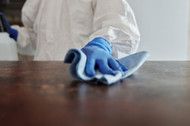5 Easy Ways to Detect Mold at Home
Nov 7th 2024
Mold is a sneaky household problem that can show up when you least expect it. It’s not just an eyesore, either – mold can cause health problems such as allergies and respiratory issues, just to name a few, and it can also damage your home.
The good news, though, is that you can often catch mold early if you know how to look. And if you do find mold, there are a few straightforward steps that you can take to deal with it. Here are some easy ways to detect mold at home and what to do next if you spot it:
What Is Mold, and Why Should You Care?
First things first – what is mold and why is it such a big deal?
Mold is a type of fungus that grows in damp, humid environments. While it’s naturally found outdoors, it can become a problem when it starts growing indoors.
So, what makes mold so dangerous? It releases tiny spores into the air, which can trigger allergic reactions or worsen respiratory conditions such as asthma. Some molds also produce mycotoxins. Mycotoxins are toxic chemicals that pose serious health risks to both humans and animals. Short-term or acute exposure can cause symptoms like nausea, vomiting, and abdominal pain, whereas long-term exposure can cause chronic health issues such as immune deficiency and cancer. Mold can also weaken the structure of your home if it spreads unchecked. It can damage walls, floors, and furniture, leading to costly repairs if not handled properly and in time.
How to Detect Mold in Your Home
1. Look for Visible Signs of Mold
The easiest way to detect mold is by doing a visual inspection of your home. Mold often appears as dark spots or patches and can range in color from black to green, white, or even orange, depending on the type.
As detailed above, mold usually grows in environments that are damp, humid, and dark. These are the areas that are worth checking first:
- Bathrooms: Mold loves the warm, damp environment around showers, bathtubs, and sinks. Keep an eye out for any patches on tiles, grout, or even the ceiling.
- Kitchens: Look for mold under the sink, around windows, or behind large appliances like the refrigerator or dishwasher where moisture can accumulate.
- Basements and attics: These spaces often have poor ventilation and often trap moisture and humidity, making them a prime location for mold. Check the walls, floors, and any areas around water sources or windows.
- Windowsills: Condensation on windows can lead to the growth of mold, especially on wood or drywall around the frame.
- HVAC systems: Mold can sometimes grow inside air ducts or vents, making it harder to see but still possible to detect if you notice dust buildup or discolored vents. The evaporator coil inside your air handler can also be a home for microbial growth if the system is not properly maintained or sized for the home.
2. Pay Attention to Musty Odors
Sometimes, mold can be hidden in places you can’t see, like inside walls or behind large pieces of furniture. A musty, damp odor is one of the tell tale signs in those cases. Even if you don’t see mold, that distinct smell can be an indicator that it’s somewhere near.
If you do smell mold, walk through your home and try to locate where the smell seems strongest. Check the usual suspects: bathrooms, basements, and any other areas that are prone to moisture. The source of the odor is often the area where mold is most concentrated.
3. Use a Mold Detection Kit
If you can’t see or smell mold but are still suffering from symptoms commonly associated with it, then you might want to use a mold detection kit like our EC3 Mold Screening Test Kit.
EC3 Mold Screening Test Kit contains everything you’ll need to test for elevated levels of mold in your indoor air or on your belongings. It includes 6 mold test plates, as well as detailed instructions on how to use the tests to see if mold is present in your indoor air or on specific items or surfaces in your home. Each test only takes a few minutes to perform, and you can use the package insert to read your results in just 5 days.
4. Check for Water Damage
Where water damage occurs, mold often follows. If you’ve recently had a leak or flooding, it’s a good idea to inspect the area where it was located for any signs of mold growth.
Some common signs of water damage worth looking for include stains or discoloration on walls and ceilings, bubbling or peeling paint or wallpaper, or dampness or moisture lingering in carpets or fabrics. Even if the leak has been fixed, it’s still possible that moisture may have gotten trapped. This creates an ideal environment for mold.
5. Monitor Humidity Levels
Mold thrives in humidity, so keeping an eye on your home’s level of humidity can help prevent it from forming in the first place. Ideally, you want to keep indoor humidity levels below 50%.
To measure your home’s humidity levels, you can pick up a hygrometer from a hardware store. If it’s consistently high, then you might want to consider using a dehumidifier – especially in places like basements, bathrooms, or closets: areas where moisture tends to build up. You may also want to consider adding more internal fans or ventilation to your home to move the air and keep things dryer.
Mold may be a common household issue, but it doesn’t have to become a serious problem if you catch it early. The tips above should help prevent mold from taking hold in your home.



